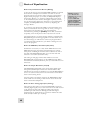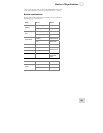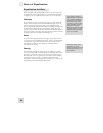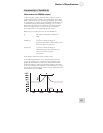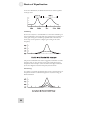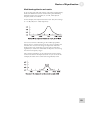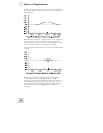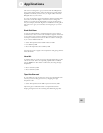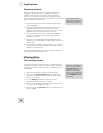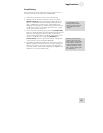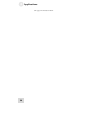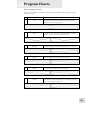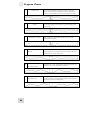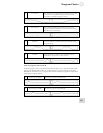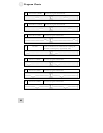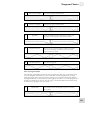
4 Applications
56
Eliminating Feedback
During a live performance, you may experience feedback if a
microphone is placed too close to a monitor. However, this
feedback often occurs at one frequency before it happens at
others. You can "ring out" the monitor by using EQ to cut the
frequency that’s feeding back. The following is best to try when the
band and audience are not present:
1. Insert the EQ between the mixer’s monitor output and the
monitor amplifier.
2. Slowly and carefully raise the monitor level to the point of
feedback. Notice that it always feeds back at the same
frequency unless the mic is moved a lot. As soon as you hear
feedback, turn the monitor level down, but not off.
3. Select a band that is near where you think the feedback is
occurring. For example, if you’re getting high-frequency
feedback, try 6.3 kHz.
4. Slowly raise the 6.3 kHz Band Gain level while listening for
feedback. If you hear feedback, cut that frequency because you
guessed right.
5. If you don’t hear feedback, return that band to “0” and repeat
this procedure with another frequency band. Once you hear
feedback, cut that frequency.
If you don’t hear feedback at any frequency using this method, try
boosting the monitor level a little more.
Filtering effects
The answering machine
A popular vocal effect is to filter the voice to a limited frequency
range. This “telephone” effect is also called “futzing,” and can be
used on any instrument or mix. Here’s how to get that sound on
the DEQ230:
1. Follow the instructions for items 1 and 2 from Step 2.
2. Press all of the [BAND SELECT] buttons in the ranges
from 25 Hz to 630 Hz and from 6.3 kHz to 20 kHz on the
channel you are using.
3. Use the [DOWN] BUTTON to reduce all of these
frequencies until their LEDs are at -12 dB.
4. Select all of the unedited frequencies and boost them as high
as you can without clipping the signal.
5. Be sure to toggle the [BYPASS] button to compare the result
with the original.
This procedure can be an
effective tool in isolating and
eliminating feedback in the
main or house system as well.
I
f the Numeric LED Display
shows “Li” when you press
[
BAND SELECT] buttons on
Channel B, it means the
channels are linked. Either
make the edits on Channel A, or
return to Program mode and
p
ress [LINK/EXIT] to unlink
the channels.



